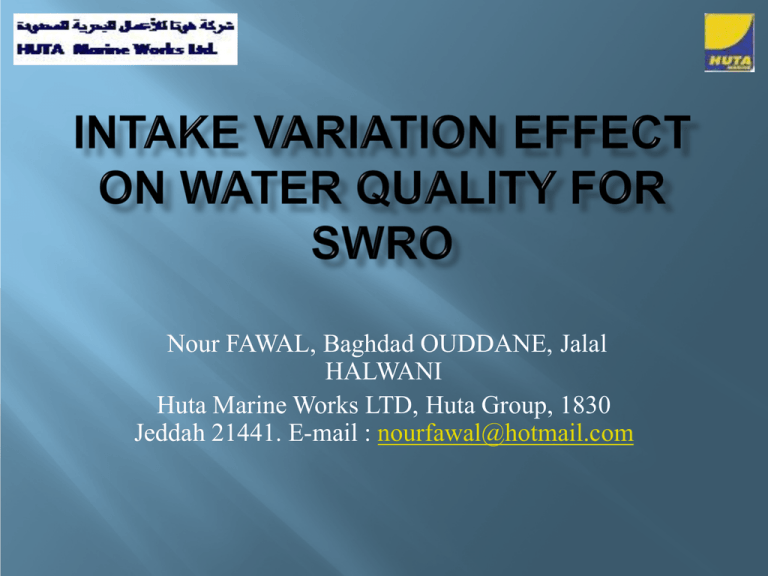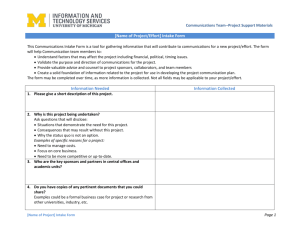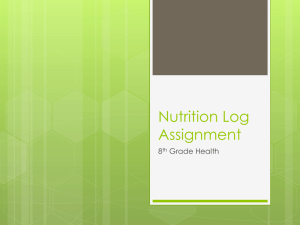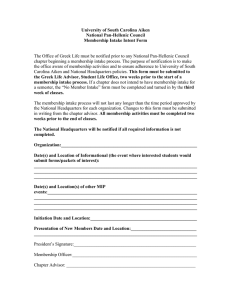Nour FAWAL, Baghdad OUDDANE, Jalal HALWANI il :
advertisement

Nour FAWAL, Baghdad OUDDANE, Jalal HALWANI Huta Marine Works LTD, Huta Group, 1830 Jeddah 21441. E-mail : nourfawal@hotmail.com 1- introduction 2- Key selection for intake factor 3- Types of intake 4- Our selection 5- Intake installation and case study 6- Conclusion Population + industry new water request tapping the sea and ocean water for desalination SWRO : intake + treatment + water discharge. The most challenging aspect is the INTAKE: technical strategy, regulatory challenges, & public perception INTAKE: decision key, general type of intake, our selection and our case study Intake designs are site specific; (15-20%) of the capital cost. Sea water intake is the essential process of SWRO since it conditions other processes. The objective is to provide reliable and consistent high-quality feed water. Improvements in the raw water quality lead to reduction in the complexity of pretreatment systems and increasing the operational reliability of facilities. 1) 2) 3) 4) 5) 6) 7) 8) Required intake capacity Regulatory region Site location types Technical options as a function of installation location Water sources characteristics Ecology and environment concerns Economic considerations Stakeholder Considerations Two main families : Surface water intake (open) and subsurface water intake In general : open intake for the large plant capacity Water quality is variable Recently trend is for the use of the subsurface intake Subsurface intake is limited for the small plant location parameter Dahab, Egypt Fuerteventura Island, Spain Al-Birk, Saudi Arabia SWCC Al-Jubail test sites Mediterranean location-spring Site 1 Site 2 DOC (mg/L) UV-254 (m−1) TOC (mg/l) UV-254 (m−1) Phytoplancton, cell/L Dissolved protein (mg/L) Dissolved carbohydrates (mg/L) TOC (mg/L) Bacteria (CFU/mL), 0 h Bacteria (CFU/mL), 24 h Bacteria (CFU/mL), 72 h Total picophyto-plankton (cells/mL) Synechococcus (cells/mL) Picoeukaryote (cells/mL) Nanoeukaryote (cells/mL) TOC (mg/L) Polysaccharides (mg/L) Humic substances + building blocks (mg/L) Low-molar mass acids & neutrals (mg/L) Low molar mass compounds (mg/L) TOC (mg/L) Polysaccharides (mg/L) Humic substances + building blocks (mg/L) Low-molar mass acids & neutrals (mg/L) Low molar mass compounds (mg/L) sea water well1 1.6 1.4 0.5 0.36 57720 2.73 1.57 2 1800 1.1 × 105 5.6 × 104 1.6 × 103 1.3 × 103 1.1 × 103 1.2 × 102 1.2 0.12 1.2 0.8 0.7 0.55 0 0.75 0.52 1.2-2 1300 3.3×105 4.0×106 1.3×102 1.0×102 1.9×101 1700 0.9 0.01 0.5 0.4 0.25 0.16 0.33 0.9 0.4 0.29 0.6 ND 0.26 0.16 0.22 0.13 0.38 0.3 ADVANTAGE 1. 2. 3. 4. 5. 6. Suitable for most terrains and projects High flow capacity Relatively easy to build (save time) Low cost Rapid implement solution Smaller footprint and less visual impact on the seashore DISADVANTAGE 1. 2. 3. 4. 5. 6. Lower and more variable feed water quality Poor water quality Vulnerable to marine variation conditions Requiring costly pretreatment Higher operational cost Significant environmental impact during operation ADVANTAGE 1. 2. 3. 4. 5. Water quality improved Stable water quality for long term Reduce cost of pretreatment & operation Respect the aquatic life Less vulnerable DISADVANTAGE 1. 2. 3. 4. 5. 6. 7. Limited flow capacity Higher risk of insufficient flow capacity Additional pretreatment maybe required Plug of interstitial pore Slow implement solution in case of problem Environmental impact: groundwater, coastal beauty and mud High construction cost Our plant capacity is 20.000 m3/d The cost geology (sandy beach) Stable cost with low wave activity Perfect condition to use the subsurface intake Time Available of pre-treatment facilities Project duration Stable sea water Specific Precautions Stakeholder decision Sea bed of Rabigh beach characteristic Available aqua organisms No boat or ship movement Sea water stable with turbidity around 0.6 NTU No permit to be directly near the shoreline: 340 m to reach the shoreline and 90 m inside the sea False information : sub-contractor install only15m in the sea Decision: start running EC = 42.840 – 43.356 µS/cm (43.119) pH = 7.7 – 8.3 (7.88) SDI = 7.16 – 8.12 (7.5) Temp. = 28.1 – 35.4 °C (31.9 °C) GRP pipe is only 15 m inside the sea Laying down along the sea ground level No wet well sump 3 storage tanks (22.000 m3) each Production rate 2*9600 m3/d Delivery 6000-8000 m3/d = 11 working days to stop Target : to extend the intake GRP pipe to 90m 7 GRP pipes have been damaged 2 options : stop or continue with the available New situation: 40m from the shoreline, 3 m water column above the intake point & 5 m above the sea ground level EC = 39.000 – 42.700 µS/cm (41.459) pH = 7.5 – 8.7 (7.96) SDI = 5.7 – 7.1 (6.5) Temp. = 26.8 – 33.8 °C (30.9 °C) 5 GRP pipes arrived, modification started New situation: 90m inside the sea; 8-9 m of water column above the intake point; 14m above the sea ground level EC = 38.900 – 41.900 µS/cm (40.502) pH = 7.6 – 8.9 (8.1) SDI = 5.0 – 5.9 (5.5) Temp. = 24.4 – 32.1 °C (29.1 °C) Coast guard forced the remove of the intake pipe Intake pipe removed & replaced New situation: Water deep around 1m, water quality deteriorated & high temperature EC = 41.100 – 53.700 µS/cm (47.687) pH = 7.5 – 8.9 (8.2) SDI = 7.7 – 11.7 (10.37) Temp. = 25.3 – 31.2 °C (28.7 °C) Decision taken to create a natural filtration system Stone and gravel have been used EC = 42.000 – 47.600 µS/cm (45.286) pH = 7.5 – 8.1 (7.8) SDI = 9.1 – 10.8 (10) Temp. = 20.2 – 29.2 °C (26.2 °C) Researches support to have deep water HUTA is the first dredging company in KSA & have the needed dredger One dredger was nearby our location Decision has been taken to modify the water deep All the approve and access have been arranged Target: to dredge an intake area of 20*10m with 12m water deep The New Manhole New situation: 4 m above the sea ground level, 6 m below the sea level, 2 m away from the shoreline EC = 41.700 – 48.900 µS/cm (44.979) pH = 7.7 – 8.4 (8) SDI = 6 – 10.6 (8.7) Temp. = 20.1 – 28.3 °C (25.5 °C) Addition of gravel and stone New situation: same previous condition + natural filter EC = 39.000 – 44.600 µS/cm (43.164) pH = 7.1 – 8.5 (8.2) SDI = 6.5 – 7.7 (7.3) Temp. = 24.2 – 30.8 °C (27.6 °C) Situation of Point intake depth 18-25/09 near coast along 0.8 m with seabed Far from Cond. cost µS/cm 14 m 43119 SDI pH T °C 7.5 7.9 32 5-18/10 In the depth sea 3 m water/6m seabed 40 m 41459 6.5 7.9 31 27/1027/11 In the depth sea 9m water/12m seabed 90 m 40502 5.5 8.1 29 5-17/12 Near the coast 0 m (30 cm from seabed 2m 47687 10.4 8.2 29 23/12 – Near coast + 0m 10/1 gravel and stone 2m 45286 10 7.8 26 1-24/02 2m 44979 8.7 8 25 2m 43164 7.3 8.2 28 Period 6- Conclusion Best working condition with the maximum water deep Better coordination must be applied The open intake helped the quick action to modify the situations during the shorted possible time. Near coast manhole + 8m 4/3 – 4/5 Near coast+manhole+ gravel+stone 8m THANK YOU





